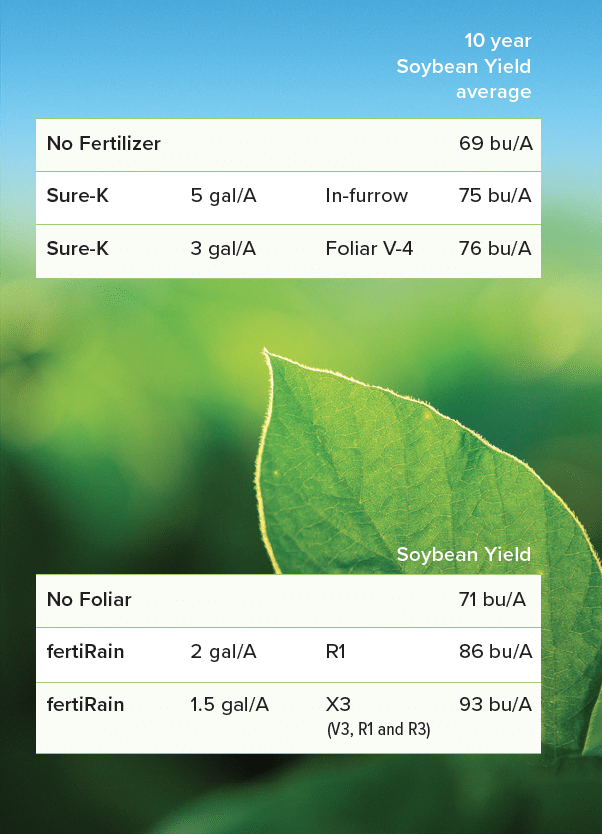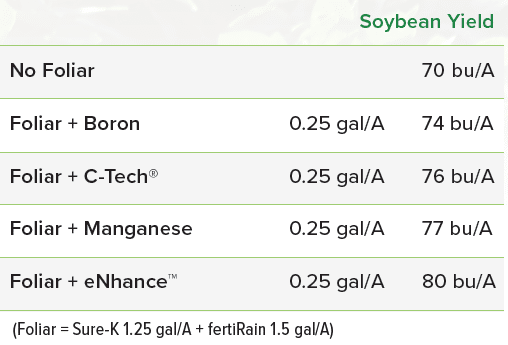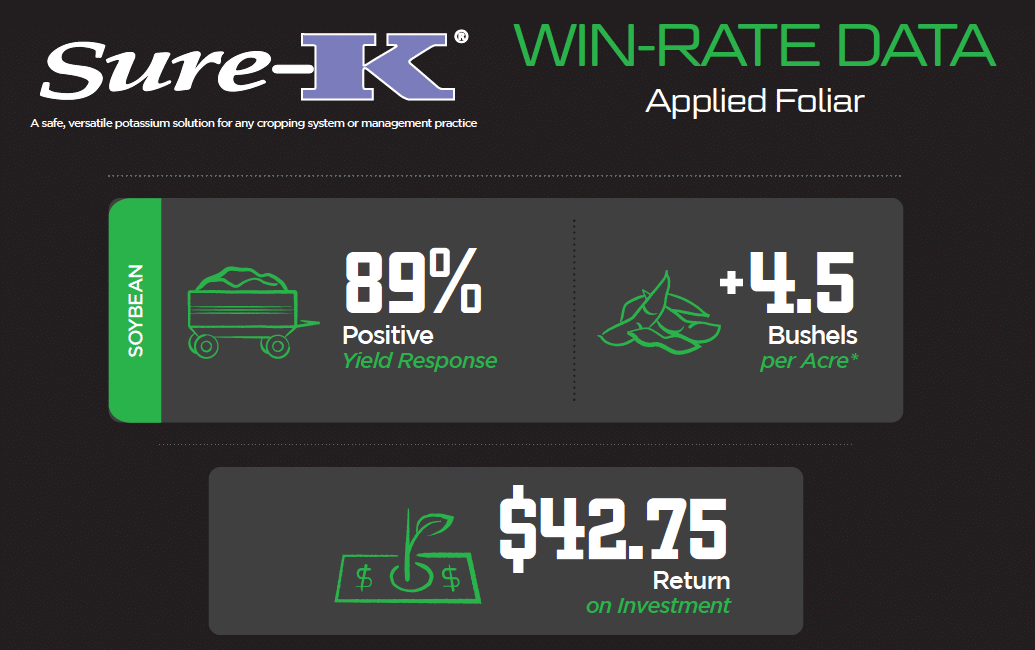Foliar feeding soybeans allows the crop to absorb nutrients when they are in critical growth stages, and also avoids many common problems that cause nutrient loss in the soil. Several AgroLiquid fertilizers are ideal for foliar feeding, and can be quickly applied to bolster plant growth at pivotal times. A good soybean crop nutrition plan must be based on crop need and soil analysis. That program will usually start with soil application of phosphorus, potassium, sulfur and micronutrients, as needed. Splitting the applications of those nutrients may be the best way to maximize yield.
Soybeans require large amounts of potassium (K), sulfur (S), and calcium (Ca). They also require micronutrients such as manganese and iron to meet their yield potential. In addition to soil applications of those nutrients, soybeans often respond to foliar applications. Sure-K® and fertiRain® products are well suited to provide cost-effective crop nutrition when applied as foliar treatments.
What does the research say about foliar feeding soybeans?
 Sure-K is a flexible potassium product that can be used in foliar applications with very consistent performance and minimal risk of crop injury. AgroLiquid has conducted trials at the North Central Research Station (NCRS) in Michigan, as well as locations across North America, that demonstrate the performance of Sure-K in soybeans.
Sure-K is a flexible potassium product that can be used in foliar applications with very consistent performance and minimal risk of crop injury. AgroLiquid has conducted trials at the North Central Research Station (NCRS) in Michigan, as well as locations across North America, that demonstrate the performance of Sure-K in soybeans.
Sure-K was applied for 10 consecutive years in a corn-soybean rotation as a soil applied treatment and as a foliar treatment. Over the 10 years of the trial, the foliar application of Sure-K at 3 gal/A consistently performed as well as Sure-K applied at 5 gal/A in-furrow.
FertiRain is a combination of nitrogen, phosphorus, potassium, sulfur, and micronutrients, specially formulated to provide balanced crop nutrition with minimal risk of crop injury when applied to foliage. Research with fertiRain demonstrates its performance as a foliar treatment, and its flexibility as a partner with other AgroLiquid products to provide the necessary nutrition for soybeans.
When applied alone, fertiRain provides excellent potassium nutrition along with nitrogen, phosphorus, and sulfur. Application timings are flexible, and it can be tank mixed with many crop protection products.
The Right Mix
Sure-K and fertiRain can be applied alone, or in combination with each other or other crop nutrients. Soybeans will often require more potassium than fertiRain alone can provide, and fertiRain can provide additional nitrogen, phosphorus, and sulfur to Sure-K.

AgroLiquid products provide many options for supplying foliar crop nutrition. Sure-K + fertiRain combinations, or fertiRain alone can provide comparable, cost-effective results. Additional sulfur or micronutrients can also provide improved crop yield, depending on soil and environmental conditions.

Performance Consistency is Key
Product performance consistency is as important as individual trial results. AgroLiquid has evaluated yield response to foliar applied Sure-K across more than 170 locations since 1998. Those trials showed a high level of performance consistency and economic benefit. The economic response was calculated using the soybean market price and fertilizer costs appropriate for the year each trial was conducted.
Soybeans require potassium and other nutrients throughout the growing season. Foliar applications of Sure-K, fertiRain, sulfur and micronutrients can help boost plant health and yield potential. They can also be a benefit in dry conditions that may limit potassium availability through the soil.

Data compiled from 184 trials.
Interested in learning more about foliar applications to soybeans? We have more than 25 years of research data available. Check it out!

